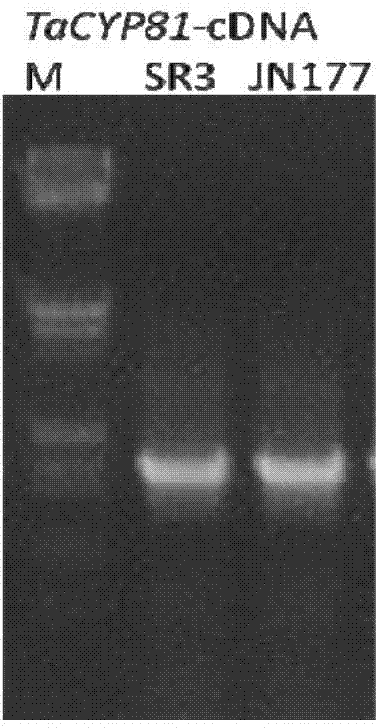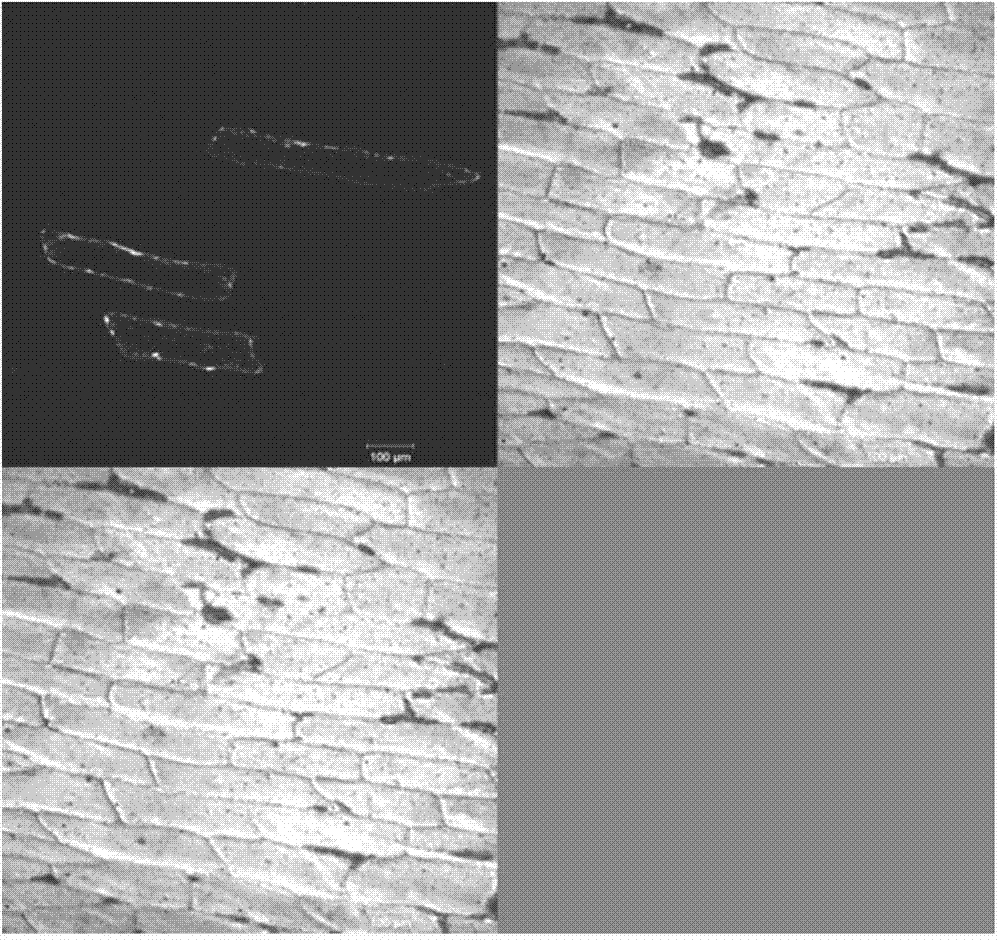Wheat salt-tolerant gene TaCYP81 and application thereof
A wheat salt tolerance gene and gene technology, applied in the application, genetic engineering, plant genetic improvement and other directions, can solve the problem that the effect has not yet been reported, and achieve the effect of improving the salt tolerance and salt tolerance of wheat
- Summary
- Abstract
- Description
- Claims
- Application Information
AI Technical Summary
Problems solved by technology
Method used
Image
Examples
Embodiment 1
[0029] Embodiment 1, the cloning of TaCYP81
[0030] 1.1 Extraction of wheat Total RNA
[0031] 1. Put the tissue material into a liquid nitrogen pre-cooled mortar, and fully grind it into powder in liquid nitrogen;
[0032] 2. After the liquid nitrogen is evaporated to dryness, transfer it to a 2ml centrifuge tube immediately, add about 1ml of Invitrogen’s TRIzol extract for every 100mg of material, after melting, repeatedly suck and blow with a sample gun, shake and mix the sample vigorously, and make the sample Fully lyse and place at room temperature for 5 minutes;
[0033] 3. Add 0.2ml of chloroform (chloroform), vigorously shake and mix for 15 seconds, and place at room temperature for 10 minutes;
[0034] Centrifuge at 12000 rpm for 15 minutes at 4.4°C;
[0035] 5. Carefully suck out the upper aqueous phase with a pipette, add it to a new 1.5ml centrifuge tube, add 500μl of isopropanol (1:1 volume), mix well, and settle at -20°C for 30min or overnight;
[0036] 6.4°...
Embodiment 2
[0081] Embodiment 2, the construction of plant expression vector (35S promoter)
[0082] 2. Construction of 135S promoter plant expression vector
[0083] Using the plant expression vector pROK2, select SacI and BamHI to carry out double enzyme digestion on pROK2 and the pEASY-T1 vector containing the target gene respectively, recover the large fragment of the vector and the small fragment of the target gene, and use T 4 After DNA ligase ligation, the E. coli DH10B competent cells were transformed, and the plant expression vector with the target gene was obtained after the recombinant was identified.
[0084] (1) SacI and BamHI double digestion of plasmid pROK2 empty vector and pEASY-T1
[0085] The pROK2 empty vector and pEASY-T1 plasmid were extracted by alkaline lysis, and 10 μg of each was digested. The enzyme digestion system was as follows:
[0086]
[0087] Enzyme digestion was carried out in a constant temperature water bath at 30°C for more than 2 hours. After d...
Embodiment 3
[0098] Embodiment 3, preparation and transformation of Agrobacterium competent
[0099] 3.1 Preparation of Competent Agrobacterium AGL1 / EHA105
[0100] (1) A single colony of Agrobacterium tumefaciens was picked from a YEP plate (containing 50 μg / ml rifampicin), inoculated in YEP liquid medium containing 50 μg / ml rifampicin, cultured overnight at 200 rpm / min at 28°C.
[0101] (2) Inoculate 2ml of the overnight culture solution into 50ml of YEP liquid medium containing the same antibiotic and cultivate to OD under the same conditions 600 up to 0.5.
[0102] (3) Bacteria solution was bathed in ice for 30 minutes, centrifuged at 5000 rpm for 10 minutes at 4°C, and the bacteria were collected.
[0103] (4) Resuspend the bacteria in 10 ml of 0.15 mol / L NaCl in an ice bath, and collect the bacteria by centrifugation.
[0104] (5) Resuspend in 1ml of 20mmol / L ice-cooled CaCl 2 In the solution, divide the bacterial liquid into 1.5ml Eppendorf tubes at 200 μl / tube, freeze in liquid...
PUM
 Login to View More
Login to View More Abstract
Description
Claims
Application Information
 Login to View More
Login to View More - R&D
- Intellectual Property
- Life Sciences
- Materials
- Tech Scout
- Unparalleled Data Quality
- Higher Quality Content
- 60% Fewer Hallucinations
Browse by: Latest US Patents, China's latest patents, Technical Efficacy Thesaurus, Application Domain, Technology Topic, Popular Technical Reports.
© 2025 PatSnap. All rights reserved.Legal|Privacy policy|Modern Slavery Act Transparency Statement|Sitemap|About US| Contact US: help@patsnap.com



